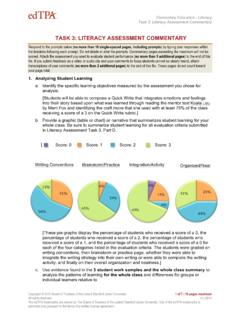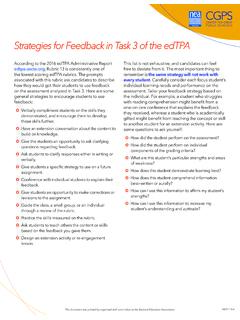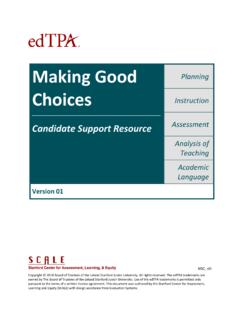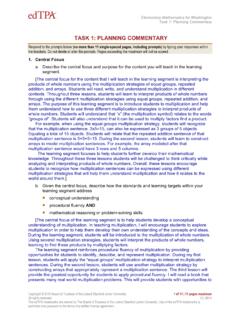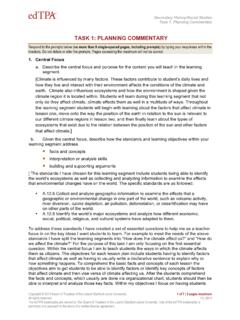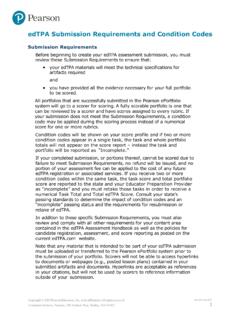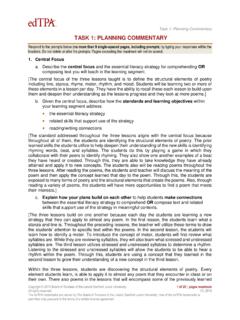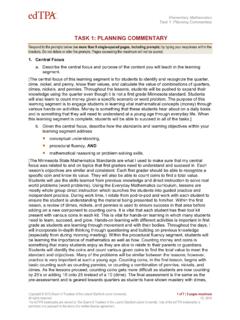Transcription of TASK 1: PLANNING COMMENTARY - My Teaching Portfolio
1 Elementary Education Task 1: PLANNING COMMENTARY TASK 1: PLANNING COMMENTARY . Respond to the prompts below (no more than 9 single-spaced pages, including prompts) by typing your responses within the brackets. Do not delete or alter the prompts. Pages exceeding the maximum will not be scored. 1. Central Focus a. Describe the central focus and the essential literacy strategy for comprehending OR. composing text you will teach in the learning segment. [The school curriculum requires that the first grade students conduct an author study on Mem Fox, a famous Australian author. The students must learn specific writing strategies that Mem uses within her writing and incorporate those writing strategies into their independent writing pieces. Therefore, the central focus of these four lessons is to have students integrate new writing strategies into their own writing style based upon the craft moves that were identified within the mentor texts. Three mentor texts written by Mem Fox will be introduced to the students, and each text contains a specific craft move, or writing strategy, that makes the text exciting to read, such as sensory imagery.]
2 The students will be learning how to integrate emotions, sensory imagery, and rhyme and repetition into their own writing in order to compose a more engaging and appealing writing piece for their audience. These four lessons are merely the introduction to the author study, and are considered to be an immersive writing workshop where the students are expected to identify each strategy, and then integrate the strategies into their own writing in order to become familiar with them.]. b. Given the central focus, describe how the standards and learning objectives within your learning segment address the essential literacy strategy related skills that support use of the strategy reading/writing connections [The central focus involves the students integrating new writing strategies into their own writing style. Before they are able to integrate the new strategies, they must be able to identify these specific craft moves. Therefore, the essential literacy strategy is simply having the students identify the strategies in the mentor texts.
3 With assistance and prompting from the teacher during both the read aloud and minilesson in the first writing workshop lesson , the students will be expected to identify words and phrases in the mentor text, Koala Lou, that suggest feeling. In this mentor text, Mem incorporates feelings and emotions into her story by using feeling words or emotional action words, such as cry, hide, cheer, and stomping feet. These words and phrases suggest feelings of being sad, excited, and happy within the context of the story. This essential literacy strategy of identifying the craft moves relates to words and phrases in stories or poems that suggest feelings or appeal to the senses. This standard also relates to the second lesson , where students are expected, with assistance and prompting from the teacher, to identify words within the mentor text Night Noises that appeal to the senses. This lesson focuses on sensory imagery, and the students are expected to identify that the sound words (click, clack, mutter, murmur, shh, etc.)
4 Appeal to the sense of sound. The main character's appearance is described utilizing similes and describing words, which the students are also expected to identify as appealing to the sense of sight. Within this lesson , the identified words that appeal to the five senses are labeled as sensory imagery words, and the students are required to Copyright 2015 Board of Trustees of the Leland Stanford Junior University. 1 of 9 | pages maximum All rights reserved. V4_0915. The edTPA trademarks are owned by The Board of Trustees of the Leland Stanford Junior University. Use of the edTPA trademarks is permitted only pursuant to the terms of a written license agreement. Elementary Education Task 1: PLANNING COMMENTARY integrate sensory imagery words into their own writing, as is stated in the central focus of the lesson . The third lesson involves the students identifying rhyme and repetition within the mentor text Zoo-Looking and describing how it adds a sense of excitement to the story.
5 This aspect of the lesson relates to the second grade standard Describe how words and phrases ( , regular beats, alliteration, rhymes, repeated lines) supply rhythm and meaning in a story, poem, or song. Both standards, and , relate to reading and writing connections, since the students must identify the strategies in the mentor texts (reading), and then integrate them within their own writing (writing). The students must have knowledge of numerous related skills in order to complete the task of integrating newly introduced writing strategies into their own writing. The first grade students that are being taught these four lessons are well informed when it comes to foundational skills. The writing workshop model and the Fundations program that they partake in has enabled them to become impressive writers at the first grade level. For the most part, they are able to write complete sentences that contain capitalization and punctuation, which relates to standard Demonstrate understanding of the organization and basic features of print.
6 They also exhibit the necessary skills in relation to phonological awareness, where they are able to segment syllables and blend phonemes in order to spell both simple and difficult words, which makes their writing readable and easy to decipher. The related phonological skills that they exhibit, which will assist them in composing their writing pieces, relates to standards Demonstrate understanding of spoken words, syllables, and sounds (phonemes). Throughout the four lessons, the students will be collaborating with partners during the minilessons, which relates to the standard Participate in collaborative conversations with diverse partners about grade 1 topics and texts with peers and adults in small and larger groups. The learning objectives within this learning segment address the essential literacy strategy, the related skills, and reading/writing connections. The learning objective for the first lesson states: Students will be able to compose a Quick Write that integrates emotions and feelings into their story based upon what was learned through reading the mentor text Koala Lou by Mem Fox and identifying the craft move that she used with at least 75% of the class receiving a score of a 3 on the Quick Write rubric.
7 The essential literacy strategy is addressed in the objective since it states that the students will be identifying the new craft move, or writing strategy, within the mentor text. Since the students are composing a writing piece, the related skills are implied within the objective, since the students must comprehend sentence structure and phonological awareness in order to compose a text. The reading and writing connection appear in the objective when it states, through reading the mentor text Koala Lou by Mem Fox and identifying the craft move that she As the teacher reads or reviews the mentor text, the students must identify the craft move/aspects of the craft move that Mem used and that they will later integrate into their own writing. The objectives for the following three lessons are similar in structure and therefore will also address the essential literacy strategy, the related skills, and reading/writing connections in a comparable format.]. c. Explain how your plans build on each other to help students make connections between the essential literacy strategy to comprehend OR compose text and related skills that support use of the strategy in meaningful contexts.
8 [The goal of this learning segment is to provide students with a multitude of writing strategies that they will be able to integrate into their own writing. The plans build upon each other since the students are taught a new craft move over the course of the first Copyright 2015 Board of Trustees of the Leland Stanford Junior University. 2 of 9 | pages maximum All rights reserved. V4_0915. The edTPA trademarks are owned by The Board of Trustees of the Leland Stanford Junior University. Use of the edTPA trademarks is permitted only pursuant to the terms of a written license agreement. Elementary Education Task 1: PLANNING COMMENTARY three lessons. Therefore, upon completion of the learning segment, the students will have three new writing strategies that they can continue to add to their writing throughout the duration of first grade, and they can take those strategies with them as they enter second grade. Writing in general is a process that requires skills that build upon each other.]
9 The students have already acquired the skills and strategies that it takes to form correct sentences and construct a story. Now they are being introduced to strategies that will make their writing exciting. They know the basics, so this learning segment is meant to teach them how to be creative with their writing. With each lesson , the students are able to become more and more creative with the stories they write and the craft moves they add.]. 2. Knowledge of Students to Inform Teaching For each of the prompts below (2a b), describe what you know about your students with respect to the central focus of the learning segment. Consider the variety of learners in your class who may require different strategies/support ( , students with IEPs or 504 plans, English language learners, struggling readers, underperforming students or those with gaps in academic knowledge, and/or gifted students). a. Prior academic learning and prerequisite skills related to the central focus Cite evidence of what students know, what they can do, and what they are still learning to do.
10 [Through Writing Workshop, the students have learned how to construct a narrative with a beginning, middle, and end, as well as develop stories with a problem and solution. They have written personal narratives, How-To books, and All About books that include a table of contents, diagrams, and a glossary. They typically write these stories in blank writing booklets containing 4-5 pages. The students are taught using Lucy Calkins'. Writing Workshop model. With this model, the students have developed very impressive writing skills that allow them to think outside of the box and create writing pieces that can be quite extensive in length. The students have utilized mentor texts many times prior to this learning segment, for both writing and reading workshop. They are familiar with the term mentor text and understand the concept of drawing inspiration from an author's work. They know that a craft move is a writing strategy within a mentor text that adds a level of excitement to the story.]

